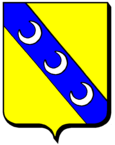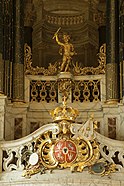Luneville
| Luneville | ||
|---|---|---|

|
|
|
| region | Grand Est | |
| Department | Meurthe-et-Moselle | |
| Arrondissement | Luneville | |
| Canton |
Lunéville-1 (main town) Lunéville-2 (main town) |
|
| Community association | Territoire de Lunéville à Baccarat | |
| Coordinates | 48 ° 35 ' N , 6 ° 30' E | |
| height | 217-321 m | |
| surface | 16.34 km 2 | |
| Residents | 18,287 (January 1, 2017) | |
| Population density | 1,119 inhabitants / km 2 | |
| Post Code | 54300 | |
| INSEE code | 54329 | |
| Website | www.luneville.fr | |
 Saint Jacques Church in Lunéville |
||
Lunéville [ly.ne.vil] (also outdated Lünstadt ) is a French commune in the Meurthe-et-Moselle department in the Grand Est region (until 2015 Lorraine ). Lunéville is the seat of the sub-prefecture of the same name , capital of the cantons Lunéville-1 and Lunéville-2 .
Lunéville is located at the confluence of the Vezouze in the Meurthe , about 30 kilometers away from Nancy . With 18,287 inhabitants (as of January 1, 2017), Lunéville is the second largest city in the Meurthe-et-Moselle department after Nancy.
history
Lunéville was once a small county and has been part of the Duchy of Lorraine since the 15th century . It owed its upswing to Leopold Joseph von Lorraine , who moved to Lunéville in 1702 when his capital Nancy was occupied by French troops. He had the baroque palace built by the architect Germain Boffrand and expanded the city into a worthy residence. An earthenware factory was established here in 1730, which was soon recognized as royal. She still makes world famous ceramic products today.

Then Stanislaus I. Leszczyński - the last Prince of Lorraine - ruled the duchy from Lunéville until the end of his life (February 23, 1766). According to the treaty, Lorraine fell to the French crown after him. On February 9, 1801, Joseph Bonaparte signed the Treaty of Lunéville for the French Republic and Johann Ludwig Graf Cobenzl for Austria . This peace agreement marks the end of the Second Coalition War and the victory of France. In terms of content, this peace treaty prepares the Reichsdeputationshauptschluss (1803).
In 1827 Prince Ludwig Aloys zu Hohenlohe-Waldenburg-Bartenstein was appointed Marshal and Peer of France . For his services he was given the Lunéville Castle as his residence. He was in command of the Hohenlohe regiment , which joined the French Foreign Legion in 1831 . Ludwig Aloys died in Lunéville on May 31, 1829.
Particularly at the beginning of the First World War , the area around the city was highly competitive. The attempt to break through by the German 6th Army on Épinal failed at the end of August 1914 due to the strong fortifications in the French defense in the Nancy / Lunéville area.
Population development
| year | 1962 | 1968 | 1975 | 1982 | 1990 | 1999 | 2007 | 2017 |
| Residents | 21,618 | 23,177 | 22,709 | 21,468 | 20,711 | 20,188 | 20,078 | 18,287 |
Attractions
The main attraction of the city is the Lunéville Castle, built in the 18th century . It was planned by the architect Germain Boffrand from 1702 and served as Duke Leopold Joseph's residence . It was badly damaged in a fire in January 2003. The Conseil Général de la Meurthe-et-Moselle in Nancy is collecting donations to restore parts of the castle that were destroyed by the fire.
Town twinning
- Schwetzingen (Germany)
- Hämeenkyrö (Finland)
Personalities
- Jean Nicolas Jadot de Ville-Issey (1710–1761), Lorraine architect
- Marie Françoise Catherine de Beauvau-Craon (1711–1786), mistress at the court of Lunéville
- Karl Alexander von Lothringen (1712–1780), Grand Master of the German Order, Field Marshal General and Governor of the Netherlands
- Niccolò Dôthel (1721–1810), flautist and composer
- Nicolas de Pigage (1723–1796), French builder
- Léopold-Charles de Choiseul-Stainville (1724–1774), Prince Archbishop and Regent of Cambrai
- Nicolas Guibal (1725–1784), French painter
- Joseph Johann von Ferraris (1726–1814), Austrian field marshal
- Sebastian von Maillard (1746–1822), planner and site manager of the Wiener Neustädter Canal
- Louis Gerverot (1747–1829), French entrepreneur and porcelain painter
- Cécile Stanilas de Girardin (1762–1827), French politician
- Charles Rupied (1762–1824), last French mayor of Old Saarbrücken (1814–1815)
- Prince Ludwig Aloys zu Hohenlohe-Waldenburg-Bartenstein (1765–1829), Marshal and Peer of France
- Etienne Bach (1892–1986), Protestant pastor and peace worker
- Georges Wambst (1902–1988), racing cyclist
- Jean-Marie Bastien-Thiry (1927–1963), French lieutenant colonel and assassin
- Claude Ponti (* 1948), French children's book illustrator and writer
Web links
- luneville.fr - Official website of the city



